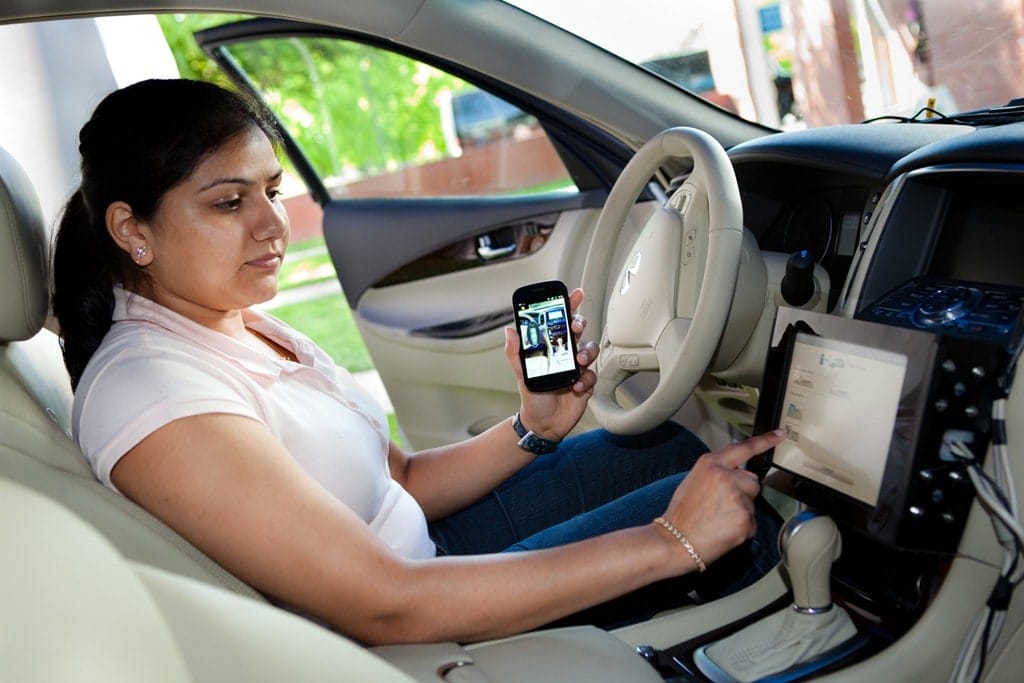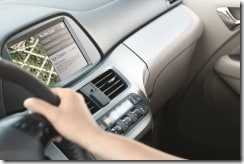I’m always “in the cloud” with my day job as Technology Evangelist for GoGrid, and all of the rest of the time, I’m working on the HighTechDad side of my life (parenting and technology). Yeah, I sleep once and a while as well. Sometimes, both of these jobs intermingle and that intersection is cloud computing. I first started talking about the cloud over 3.5 years ago as I helped launch GoGrid’s Cloud Infrastructure service; now, working for one of the global leaders in cloud technology, I’m seeing how clouds are moving beyond simply infrastructure and into our daily lives. We all use it regularly without realizing it, but most of the time, it is when we are tied to a computer or sometimes a mobile device. The future is bringing much more cloud-enablement of other commonplace items, the most obvious being cloud-connected automobiles and cloud-enhanced mobile devices.
At my work at GoGrid, we have done quite a bit leveraging Intel technology within our cloud infrastructure. A majority of our compute nodes are utilizing Intel chipsets (Nehalem and Westmere) to provide optimized performance, energy efficiency and improved productivity. And our relationship continues to grow, which is particularly nice for me because, personally, I’m also part of the Intel Advisors program. As part of the program and our monthly Advisors’ call, we are introduced to a variety of technology coming from different areas within Intel. In our June 2011 call, Manny Vara, Chief Evangelist for Intel’s R&D Labs, presented a variety of innovations coming from Intel Labs. Honestly, Intel Labs is such an exciting business unit in itself, I was completely captivated by the content of the call, specially around two topics: Cloud Computing within Automobiles and Mobile Devices.
Cloud-Enabled Automobiles
I have written some articles on “car tech” within a few Ford and Lincoln automobiles and am hoping to expand to include other manufacturers in the future. Apart from being at work and home, we spend a huge amount of time in our cars, either via a commute or just moving to and from various locations. Our autos are extensions of ourselves, making our bubble of presence much larger and enabling us to physically travel, pretty much without restrictions, to many locations.
But for the most part, our cars are pretty dumb. They are 4 wheels and an engine that moves a steel pod that protects its occupants. At least that is how cars used to be. More and more manufacturers are currently striving to make automobiles smarter, much the same way cell phones have evolved to feature phones and now to smart phones and tablets. Cars now integrate with cell phones allowing you to send and receive calls, get traffic information, stream music and even interact with you much more closely. Some automobiles are Internet-enabled, either via a link to your smartphone or via a built-in mobile receiver. And I think we are just beginning to scrape the surface of Internet-enabled vehicles.
As Manny Vara told us within the Advisor call, some departments within Intel Labs are developing technology, some of which is purely experimental and may not see the light of day, to make our cars move far beyond simple utilitarian transportation devices. Autos are getting smarter, but only internally as there are computers now that monitor a variety of aspects of your car like the safety and navigation systems. But, for the most part, these systems are closed due to security and safety concerns among other things. However, automobile manufacturers are opening up certain aspects of your car’s “infrastructure” via APIs or other interfaces – the only way to really make the most out of this is via a cellular connection.
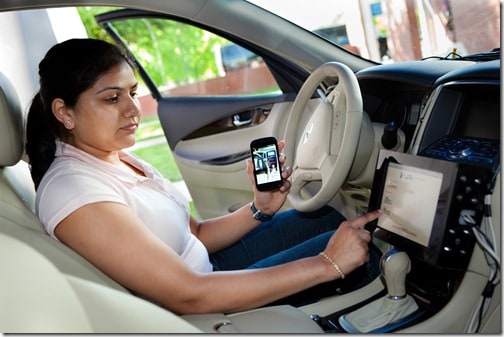
(image source: newsroom.intel.com)
Currently, to make your car “smarter”, it requires connecting it to your smartphone. In many cars, this is pretty easy to do and most of the time it works. But Intel believes that this process could be a lot easier. The hands-free connection is pretty straight forward by using simple Bluetooth pairing, but this is only for the telephony side of the equation. To connect to the Internet, cars either don’t have that capability, or it is very limited in to what you can or cannot do.
Manny described how some Intel Labs projects are working to streamline and simplify the connection process even more. One way is by using NFC (Near Field Communications) where you would tap your NFC-ready smartphone to the dashboard of a NFC-ready auto. The handshake would authenticate your smartphone as a communication device and would allow your auto to use your smartphone as a source for Internet connectivity. Another possibility would be to use a barcode scan of a code on the dashboard of the car by your smartphone to enable the easy pairing. This may be a more cost-effective method as the user would not need a NFC-equipped device and would simply use a bar-code reader and the smartphone’s camera. But essentially, making the full pairing of the smartphone to the auto does need to be simplified and Intel Labs has demonstrated a few ways to do this.
But once the connection is made and the automobile is Internet-aware and enabled, what sort of things can you do with this pairing? Assuming you are in the car, the possibilities are limitless: from watching over and monitoring key aspects of core systems in the car and being notified of pending issues to having your car even monitor your blood-sugar levels if you are a diabetic (something that Ford is already demonstrating).
However, the challenge, as I see it, is enabling connectivity to your auto when your smartphone is NOT connected to your car. There are still ways to do this via WiFi or having a cellular receiver. I think that as WiFi hotspots become more prevalent, this might be the most effective way to connect autos, but that requires your car to be in a stationary space (e.g., a parking garage). As WiMax and LTE become more mainstream (and perhaps costs of data services drop – oh that is a “pipe dream” I realize, in the terms of “data pipes”), cars that have cellular connections built in would probably be the best option.
What sort of things could you do with a cloud/internet-enabled car? Manny told us about an Infinity EX concept model that has security cameras built into the car. So, for example, if someone breaks into your car or even approaches it, you could enable the internal cameras to catch the “thief” in the act. You would be notified via an alert (e.g., SMS) that there is activity in or around your car and with your smartphone connected to the cloud, you could instantly begin streaming the video. But you see the problem here, it does require that your car’s Internet connection be always on. The video streaming would be a cloud-based service most likely.
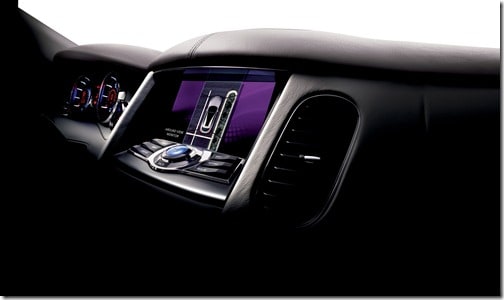
(image source: http://nissannews.com/)
Other possible applications of this technology would be for remote diagnostics where data could be streamed ahead of time to you or your mechanic, allowing for troubleshooting to take place in real-time. Similarly (and this technology already exists in a shorter range) you could remote start your car in order to cool it down or warm it up based on the outside temperature.
So, how is this cloud? In my mind, it’s more about providing cloud services like video (on demand, streaming) or data transmission and storage. Unfortunately, many people seem to lump connectivity to the Internet as being “cloud”. This really depends on the service and how it is used. I do think that Internet-connected automobiles will soon be commonplace and we will see a large number of helpful applications growing from that. Cloud or not, the technology of Intel and others will move our vehicles in more ways than just down the road…we are getting them on the Internet Superhighway!
Cloud-Accelerated Mobile Devices
A bit more applicable to cloud computing is that of what Manny described as using the cloud to get better and higher performance technology on our smartphones, even without having the physical infrastructure within those phones to do so. What does that mean? Well, our current cell phones are limited by their CPU and GPU (compute and graphics). Sure, the technology and chipsets within these mobile devices is getting better, it is still throttled by the form factor.
But Intel Labs already has demonstrated a way to overcome these physical hurtles of the CPU and GPU by offloading the processing to the cloud. Through the use of virtualization, hypervisors, high-performance computers, networking protocols and high-end chipsets, cloud computing delivers performance that can run circles around physical devices from cell phones to physical servers. The cloud delivers processing (e.g., CPU) and memory (e.g., RAM) in a manner that is scalable, on-demand and at a fraction of the cost of using physical servers. So, to capitalize on these incredible performance gains, Intel has found a way to move that performance to mobile devices without having anything physically installed in these devices.
So how do the wizards at Intel increase the performance of hand-held devices without putting in better physical hardware? By offloading these processes to a high-end cloud. Using Ray Tracing technology, Intel Labs crafted a version of Wolfenstein that put all of the heavy lifting in the cloud and then transmitted back the rendering via a real-time ray tracing engine to increase the realism of the game. Ray tracing allows for a variety of special effects including reflection, refraction, scattering and chromatic aberration to create visual realism and effects of virtual objects.
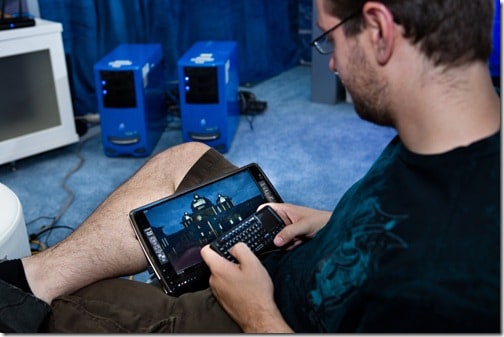
(image source: newsroom.intel.com)
Ray tracing is used for many visual effects in current movies as well as in desktop computer video games, but when you move to a mobile device, much of the 3D realism is lost due to graphics and processing limitations. What Intel Labs did was to have all of the rendering done in the cloud and then the rendered frames are pushed to the mobile device, allowing these devices to display the 3D realism without having the battery drain and crippled performance in those devices.
The initial Intel Labs tests were positive, producing the desired 3D effects on a small screen. There are still some technology hurdles to overcome. For starters, I asked Manny what type of testing environment was used, simply because even to transmit a stream of data, you need to have a fast and reliable Internet connection. Also, to compensate for the smaller data pipes of cellular devices, I assumed that the rendered frames would have to be compressed. Whenever you compress a data/media stream, you lose some fidelity and quality in the process. Manny told us that the tests were used with a wired LAN and with a WiFi connection. This makes sense as the current 3G speeds would probably not be sufficient to handle this type of data. Also, they used an 8:1 compression ratio (which, over time, they can make better). Lastly, the amount of data that your device would receive would depend on the size and resolution of the screen. Smartphones would require less data than a tablet due to their smaller screen size and would consequently display better renderings than their larger screen brethren.
However, in a few years, we could see this technology start to hit mainstream applications and devices. Mobile device manufacturers would be less hard-pressed to develop faster and more powerful hardware if these CPU and GPU processes were offloaded into the cloud for rendering and processing. A few years ago, none of this was even doable. Now it is and the speed to market is definitely picking up as the technology driving it advances.
A Cloud for Everyone
Cloud computing is enabling innovations never before thought of and doing so with minimal capital expenditure. Having a “cloud in your pocket” is something that consumers will be enjoying for years to come. What is exciting, in my opinion, is how the cloud is acting as a catalyst to technologies that were previously only seen in science fiction books and movies. The technology that we saw in the late 1960’s with Star Trek (with the exception of the warp drive, perhaps) is now something that we carry around with us in our smartphones or that is powering our automobiles.
Below is a video from the floor of Research@Intel 2011 event (also available on YouTube) which goes through a few cloud computing initiatives that Intel Labs are working on:
[iframe_loader width=”560″ height=”349″ src=”http://www.youtube.com/embed/rXy7F7FGP1g?rel=0″ frameborder=”0″ allowfullscreen]
Personally, I love the out-of-the-box (and into the cloud) thinking that Intel Labs is developing. Oh to be a fly on the wall within the Labs. But also, being directly involved with cloud computing and touting its benefits allows me to have a better understanding of the possibilities that are coming. Hopefully, this article has provided you with a glimpse into this exciting future!
Disclosure: I am part of the “Intel Advisor” program and am compensated and/or receive other value from Intel to attend events on their behalf. My opinions about Intel and my writing are entirely my own and not those of Intel, nor subject to their editorial approval. More information can be found in my About page as well as here.
HTD says: Cloud Computing is enabling current and new technologies to be even better than previously envisioned.
